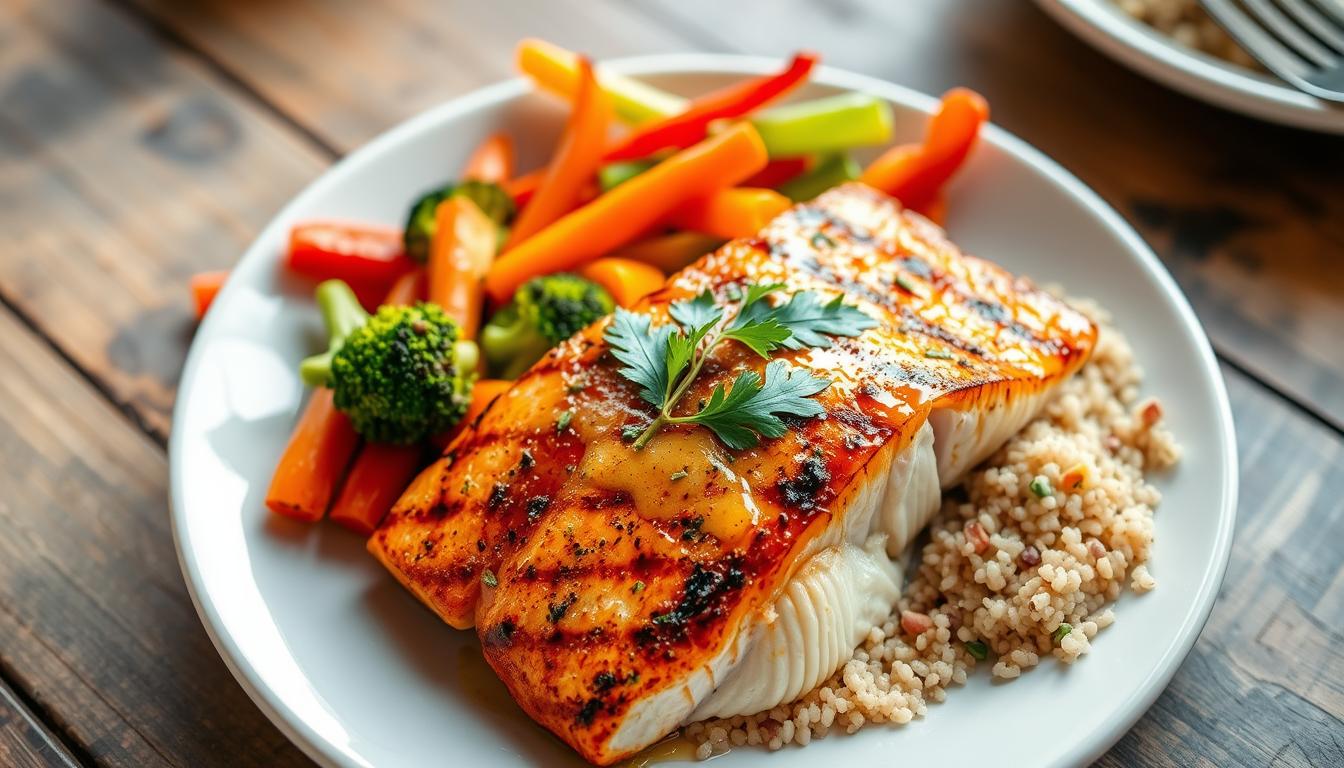Did you know that up to one in ten women of reproductive age have endometriosis? The average time to get diagnosed is seven years. This condition can cause a lot of pain and make it hard to get pregnant.
But, there’s hope. Research shows that an anti-inflammatory diet and lifestyle can help manage it. That’s why we’re sharing our tasty salmon with vegetables recipe. It’s full of omega-3s and other nutrients to help you fight endometriosis.
Salmon is loaded with omega-3 fatty acids. These help lower inflammation, which is a big problem for endometriosis. Adding a mix of veggies rich in antioxidants makes this dish even more powerful. It fights the effects of estrogen and inflammation.
So, go ahead and enjoy this healthy, endo-friendly meal. It’s packed with nutrients to support your health.
What is Endometriosis?
Endometriosis is a chronic condition that affects up to 1 in 10 women. It happens when tissue from the uterus grows outside the uterus. This tissue can grow on organs like the ovaries or bladder.
This misplaced tissue acts like the uterine lining. It thickens, breaks down, and bleeds with each cycle. But, it can’t leave the body.
Symptoms, Causes, and Effects on Fertility
The main symptom of endometriosis is pelvic pain. This pain can feel like cramping or discomfort during menstruation or sex. Other symptoms include fatigue, nausea, and digestive problems.
The exact causes are not known. But, hormonal imbalances, genetics, and immune system issues might play a part. Endometriosis can also make it hard to get pregnant. The misplaced tissue can cause scarring and change the shape of reproductive organs.
| Endometriosis Symptoms | Endometriosis Causes | Endometriosis and Fertility |
|---|---|---|
|
|
|
Endometriosis is complex and often misunderstood. Knowing about symptoms, causes, and fertility issues can help. For more info, check out this article.
The Endo-Friendly Way of Eating
Anti-Inflammatory Diet for Endometriosis Relief
For those with endometriosis, eating an anti-inflammatory diet can help manage symptoms. Focus on whole, nutrient-rich foods like leafy greens, cruciferous veggies, berries, and healthy fats. These can help lower inflammation and balance hormones.
Studies suggest that omega-3 fatty acids, vitamin D, and flavonoids can help endometriosis. Adding anti-inflammatory herbs and spices like turmeric and green tea can also be beneficial.
Good gut health is key, as endometriosis often disrupts it. Eating probiotic-rich foods is important. Also, changing our diet with our menstrual cycle can help regulate hormones and reduce inflammation.
By choosing an endo-friendly diet, we can actively manage our condition. Remember, everyone’s body is different. So, try different anti-inflammatory foods and adjust your diet to find what works best for you.
An endo-friendly diet is about nourishing our bodies with foods that reduce inflammation and support hormone balance. It’s all about improving our overall well-being.
Endo Friendly Salmon with Vegetables
Our endo friendly salmon with vegetables recipe is great for your anti-inflammatory diet. Salmon has omega-3 fatty acids that fight inflammation. The veggies add antioxidants, fiber, and phytonutrients to help with endometriosis symptoms. This meal is tasty and good for your health.
About 10% of people with a uterus have endometriosis. A study showed that a gluten-free diet helped 75% of people feel less pain. Another study found that avoiding gluten, dairy, and soy helped people feel less pain too.
Salmon, mackerel, and herring are good for omega-3s. Pastured eggs and organic fats like coconut oil are also good. Tapioca flour, teff, and oat flours are gluten-free baking options. Honey, maple syrup, and coconut sugar are better sweeteners.
Buying local produce is a good idea for nutrients. Changing your diet can help with endometriosis symptoms. An anti-inflammatory diet includes fruits, veggies, fatty fish, nuts, seeds, and healthy fats. It also limits alcohol, caffeine, dairy, sugar, and red meat.
Our endo friendly salmon with vegetables recipe is a tasty, healthy meal. It supports your body’s natural fight against inflammation and helps with endometriosis symptoms. Enjoy this easy dish as part of your healthy lifestyle.
Benefits of Salmon for Endometriosis
Omega-3 Rich and Anti-Inflammatory
People with endometriosis can benefit from eating salmon. It’s full of omega-3 fatty acids, which fight inflammation. Research shows omega-3s can slow down the growth of endometrial lesions and reduce inflammation linked to endometriosis.
The healthy fats in salmon also help with hormone balance, fertility, and reproductive health. These areas are often affected by endometriosis.
A 2013 study found that eating more veggies and omega-3 fatty acids can help fight endometriosis symptoms. On the other hand, red meat, trans fats, and coffee might worsen symptoms. A 2015 review also noted that a diet full of fruits, veggies, whole grains, and omega-3 fatty acids can prevent endometriosis.
Eating more salmon and other anti-inflammatory foods can help manage endometriosis symptoms naturally. It can offer relief from pain and help manage this complex condition.
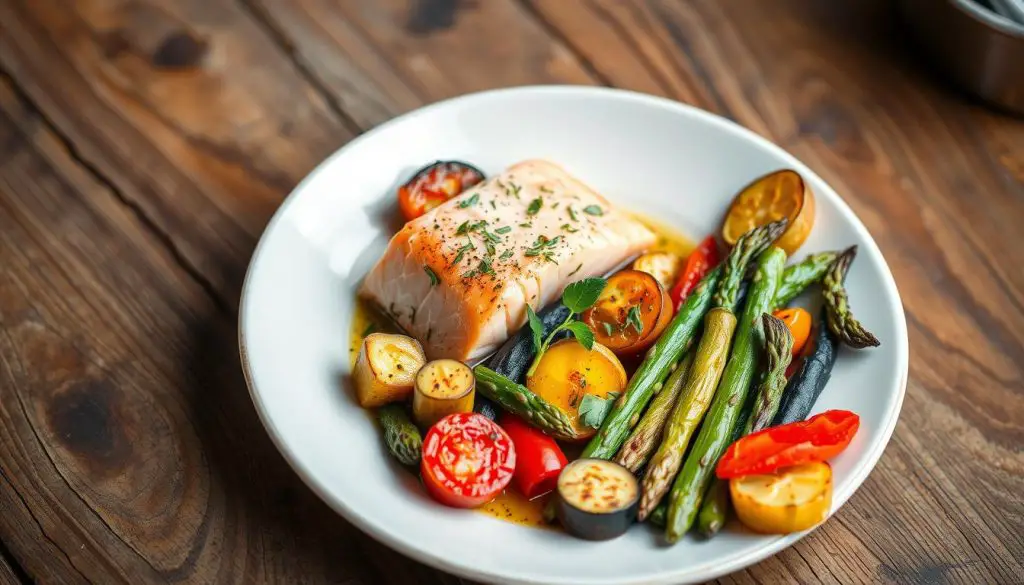
Cruciferous Veggies Aid Estrogen Detoxification
If you have endometriosis, adding cruciferous veggies like broccoli, kale, cauliflower, and Brussels sprouts to your meals can change your life. These veggies are full of nutrients that help your liver get rid of extra estrogen. This is a big help in fighting endometriosis symptoms.
Research finds that eating green veggies more than twice a day can lower your risk of endometriosis by 70%. This is because these veggies have phytonutrients that help your body get rid of estrogen. This can reduce inflammation and make your symptoms less painful.
It’s key to know that raw cruciferous veggies are very good for you but might not be the best choice for everyone. They have goitrogens that can affect your thyroid. To avoid this, lightly cooking your greens is a good idea. This way, you keep their good stuff while reducing the goitrogens.
Adding a variety of cooked cruciferous veggies to your endometriosis-friendly diet is a smart move. It helps manage your condition and cuts down on estrogen. It’s a natural way to help your body detox and ease your symptoms.
| Cruciferous Vegetable | Benefits for Endometriosis |
|---|---|
| Broccoli | Contains sulforaphane, which helps the liver metabolize estrogen |
| Kale | Rich in indole-3-carbinol, which supports healthy estrogen balance |
| Cauliflower | Provides glucosinolates that promote estrogen detoxification |
| Brussels Sprouts | High in fiber to bind and eliminate excess estrogens |
By making cruciferous veggies a regular part of your diet, you can take an important step in managing endometriosis estrogen detox and reducing the impact of this chronic condition.
Filling Your Plate with Plants
Managing endometriosis means eating a diet rich in plant-based foods. These foods help reduce inflammation and regulate hormones. They also provide essential vitamins and minerals for your body.
Leafy Greens, Berries, and Healthy Fats
Begin with leafy greens like spinach and kale. They are full of antioxidants, B vitamins, and fiber. Berries are packed with polyphenols that fight inflammation and pain. Healthy fats from avocados, nuts, and seeds help with hormone balance and pain relief.
These plant foods together form a diet that fights endometriosis symptoms. It improves your overall health and wellbeing.
| Nutrient-Dense Plant Foods | Benefits for Endometriosis |
|---|---|
| Leafy Greens (spinach, kale) | Anti-inflammatory antioxidants, B vitamins, fiber |
| Berries | Polyphenols to lower inflammation and pain |
| Healthy Fats (avocados, nuts, seeds) | Hormone regulation, reduced discomfort |
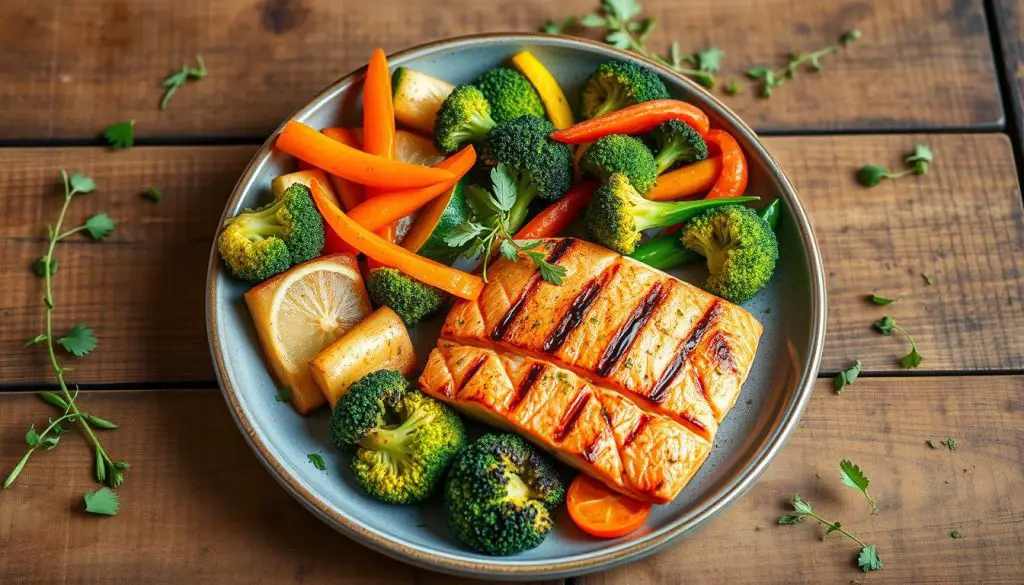
Eating plants as the base of your diet helps manage endometriosis. It also supports your overall health and wellbeing.
Avoiding Inflammatory Foods
Managing endometriosis is more than just eating anti-inflammatory foods. It’s also about avoiding foods that can make symptoms worse. Foods high in caffeine, sugar, and gluten can upset blood sugar and hormones, leading to more pain.
By cutting down on these foods and eating whole, natural foods, you can help manage your symptoms. Let’s look at why these foods are bad and how eating better can help.
Caffeine
- Caffeine can make inflammation worse and mess with hormone levels, making endometriosis symptoms worse.
- Too much caffeine, found in coffee, tea, energy drinks, and some sodas, can cause more pain and heavy bleeding.
- Try to stick to no more than 200mg of caffeine a day, or about two cups of coffee. Choose decaf when you can.
Sugar
- Added sugar and refined carbs can cause inflammation, leading to more pain and symptoms.
- Limit processed foods, baked goods, sweet drinks, and even some fruits and veggies with high sugar.
- Eat more whole, unprocessed foods that are naturally low in sugar, like leafy greens, berries, and healthy fats.
Gluten
- For some with endometriosis, gluten can cause inflammation and make symptoms worse.
- Gluten is in wheat, barley, rye, and many processed foods. Choosing gluten-free options can help.
- Try a gluten-free diet for a while and see how your body reacts to find out if it’s a problem for you.
By watching out for these foods and cutting back, you can help manage your endometriosis symptoms. Remember, everyone reacts differently to food. Listen to how your body feels and adjust your diet as needed.
Supporting Gut Health for Endo Relief
Research shows a strong link between gut health and endometriosis. Eating foods rich in probiotics and fiber, and avoiding triggers, helps manage symptoms. This proactive approach can ease the pain of this chronic condition.
A healthy gut is key to reducing inflammation, regulating hormones, and controlling the immune system. These are vital for managing endometriosis. Gut health endometriosis and probiotics endometriosis are now major areas of study for natural treatments.
- Eat probiotic-rich foods like yogurt, kefir, sauerkraut, and kimchi to support your gut.
- Add fiber-rich fruits, vegetables, and whole grains to feed good bacteria in your gut.
- Stay away from foods that can harm your gut, such as processed meats, refined carbs, and too much alcohol.
By focusing on gut health, we can manage endometriosis symptoms better. A balanced diet is a powerful tool in our fight against endo.
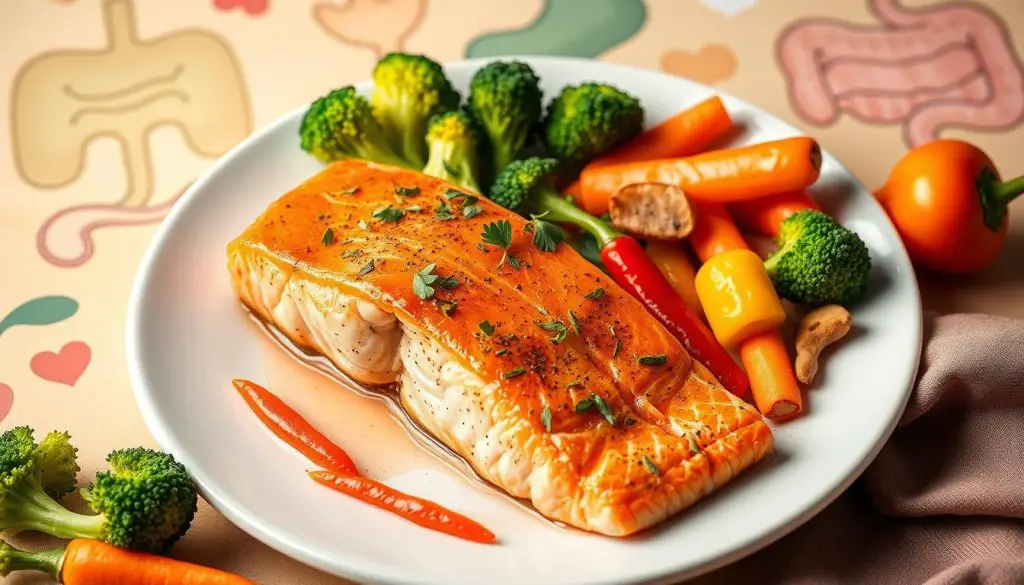
Boosting Melatonin Production Naturally
Managing endometriosis can be tough, but boosting melatonin naturally might help. Melatonin is a hormone that can lessen pain from endometriosis. While supplements may not work for everyone, eating foods that boost melatonin is a safe way to ease symptoms.
Foods like bananas, cherries, pistachios, and mushrooms are good for melatonin. Adding these natural melatonin foods to your diet can help your body make more melatonin. This might reduce some of the pain from melatonin endometriosis.
Women with endometriosis often have trouble sleeping, which makes symptoms worse. Eating foods and living a lifestyle that supports melatonin can improve sleep. This could also lessen the pain from endometriosis.
| Food | Melatonin Content | Additional Benefits |
|---|---|---|
| Bananas | Rich in melatonin and tryptophan, a precursor to melatonin | High in magnesium, which aids in melatonin production and sleep quality |
| Cherries | One of the highest natural sources of melatonin | Contain antioxidants and anti-inflammatory compounds |
| Pistachios | Rich in melatonin, vitamin B6, and magnesium | Provide healthy fats and fiber to support overall health |
| Mushrooms | Contain melatonin and vitamin D, which regulates melatonin production | Offer anti-inflammatory properties and support immune function |
Eating natural melatonin foods can help manage melatonin endometriosis and improve your health. A holistic approach that includes sleep, nutrition, and lifestyle is key to dealing with endometriosis.
Eating for Your Cycle Phases
Knowing your menstrual cycle phases is vital for managing endometriosis. By eating different foods for each phase, you can balance your hormones and regulate your period. This also helps lower inflammation and food sensitivities.
In the follicular phase, estrogen starts to rise, getting your uterine lining ready for pregnancy. This is the time to eat foods rich in nutrients like leafy greens, citrus fruits, and whole grains. They offer B vitamins, vitamin C, and fiber, aiding in healthy estrogen levels.
As you get closer to ovulation, around day 14, testosterone peaks. Eat foods that fight inflammation, such as salmon, walnuts, and turmeric. This helps keep your hormones in check and reduces stress.
In the luteal phase, progesterone increases to get your uterus ready. Eat foods rich in magnesium, zinc, and healthy fats like avocados and olives. These support your progesterone and overall hormone health.
The menstrual phase is when you focus on replenishing iron, B vitamins, and omega-3s. Include foods like spinach, lentils, and salmon in your diet. These can help ease cramps, regulate your flow, and improve your cycle wellness.
By matching your diet to your menstrual cycle, you can use nutrition to balance your hormones and reduce endometriosis symptoms. Try adding these specific foods to your diet and see how your body reacts.
Simple Salmon with Vegetable Medley Recipe
Try this tasty endo-friendly salmon with vegetables recipe. It’s full of omega-3s from the salmon and fiber, antioxidants, and phytonutrients from the veggies. This meal is great for quick weeknight dinners or meal prep. Just roast the salmon and veggies together for a fast, one-pan dinner that’s good for an anti-inflammatory diet.
Ingredients
- 1 (4 oz) salmon fillet
- 1 cup cooked quinoa
- ¼ cup diced mango
- ¼ cup edamame beans
- ¼ cup roasted butternut squash
- ¼ cup broccoli florets
- ¼ cup diced avocado
- ⅛ cup pickled ginger
- 1 tbsp white and black sesame seeds
- 1 tbsp canola oil
Creamy Wasabi Honey Dressing
- 1 tbsp honey
- 2 tbsp plain yogurt
- ½ tbsp sesame oil
- ¼ tsp rice wine vinegar
- ¼ tsp wasabi paste
- ½ tsp salt and pepper
Instructions
1. Preheat the oven to 400°F. Heat a pan over medium heat for 2 minutes.
2. Place the salmon fillet in the pan and sear for 5 minutes, then flip and sear for another 5 minutes. Add a squeeze of lemon juice and a minced garlic clove to the pan.
3. Transfer the salmon to a baking sheet and roast for 10-12 minutes, or until the internal temperature reaches 145°F.
4. While the salmon is cooking, prepare the vegetable medley. Toss the quinoa, mango, edamame, butternut squash, broccoli, avocado, and pickled ginger with the canola oil and season with salt and pepper.
5. Spread the vegetable mixture on a separate baking sheet and roast for 15-20 minutes, stirring halfway, until the vegetables are tender.
6. Make the Creamy Wasabi Honey Dressing by whisking together the honey, yogurt, sesame oil, rice wine vinegar, wasabi paste, salt, and pepper.
7. Serve the roasted salmon on top of the vegetable medley, drizzled with the Creamy Wasabi Honey Dressing. Sprinkle with the sesame seeds.
Meal Prep Ideas for Busy Weeks
Meal prepping endo-friendly foods is a big help for managing endometriosis. It makes it easier to eat right and avoid foods that can trigger symptoms. Here are some tasty and easy meal prep ideas to help you on your endometriosis journey.
Roasting trays of salmon and vegetables are a favorite prep-ahead choice. They offer a protein-rich, omega-3 packed main dish. You can serve it with leafy greens, quinoa, or brown rice for a balanced meal. Plus, marinating the salmon in anti-inflammatory spices and herbs adds extra flavor.
Another great idea is making big salads or grain bowls. Use nutrient-dense leafy greens as the base. Top them with avocado, nuts, seeds, and a balsamic vinaigrette. These can be portioned out for easy lunches or dinners.
Batch-cooking soups or stews is also smart. Use ingredients like bone broth, turmeric, and ginger for their gut-healing benefits. These dishes are filling and can be frozen for quick reheats.
With a bit of planning, you can have delicious, endometriosis-friendly meals ready, even when you’re super busy. Focusing on your nutrition is key, and meal prepping is a great way to support your body.
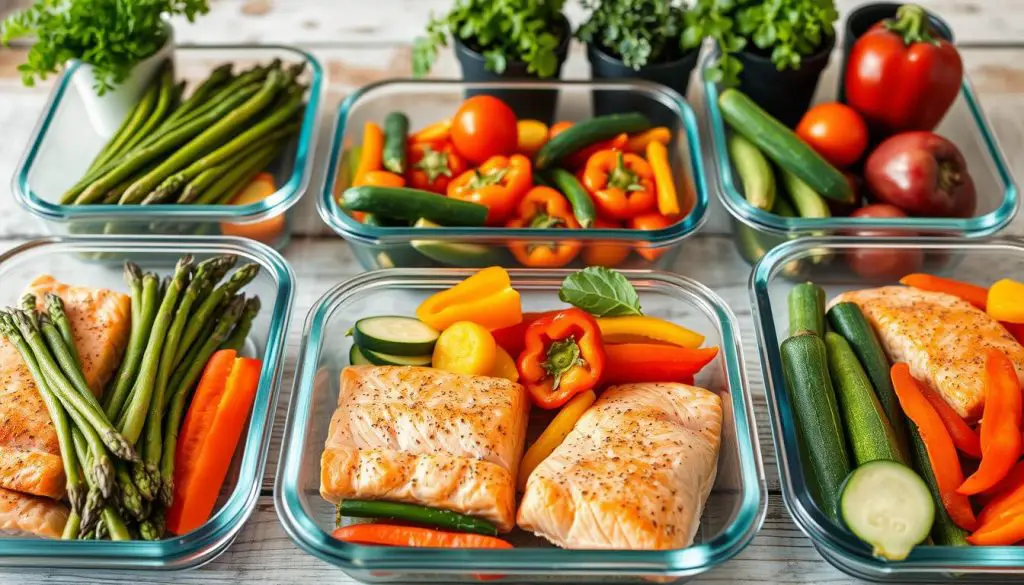
Snack and Beverage Options
Living with endometriosis means we need to take care of our bodies in many ways. Eating the right endometriosis snacks and endo friendly beverages can make a big difference. Choosing foods and drinks that fight inflammation helps us manage our symptoms and feel better overall.
When we’re in pain, having healthy snacks ready can help fast. Try fresh fruit, raw endometriosis snacks like carrots and cucumber with hummus, or nuts and seeds. Even a little dark chocolate can be a comforting treat.
Drinking plenty of water is key, and herbal teas like chamomile or ginger can really help. Smoothies with greens, berries, and spices like turmeric are also great endo friendly beverages. Having these snacks and drinks on hand helps us deal with the ups and downs of endometriosis.
The best snacks and drinks for endometriosis are whole, unprocessed foods. They should be full of fiber, healthy fats, and important vitamins and minerals. Try different things to find what works best for you.
Tips for Managing Endometriosis Flare-Ups
Living with endometriosis can be tough, with unpredictable flare-ups and constant symptoms. But, there are ways to manage these issues. By eating right and making lifestyle changes, we can handle the ups and downs of this condition better.
Doing gentle exercises like yoga or walking can help. These activities ease pain, boost blood flow, and cut down on swelling. Using heating pads or ice packs on sore spots can also bring relief.
Trying to reduce stress with meditation or deep breathing is very helpful. Getting enough quality sleep is also key for managing symptoms and feeling better overall.
Talking to our healthcare team and trying complementary therapies like acupuncture or massage can help too. By trying different things, we can find what works best for us and manage our condition better.
| Endometriosis Flare-Up Management Strategies | Benefits |
|---|---|
| Gentle, low-impact exercise (e.g., yoga, walking) | Alleviates pain, improves circulation, reduces inflammation |
| Heating pads or ice packs | Provides soothing relief for affected areas |
| Stress-reduction techniques (e.g., meditation, deep breathing) | Manages emotional and physical aspects of endometriosis |
| Ensuring quality sleep | Promotes overall well-being and symptom management |
| Communicating with healthcare team and trying complementary therapies | Provides additional relief options during flare-ups |
By using these tips, we can manageendometriosis flare-ups better. We can findendometriosis pain relief and control ourendo symptoms more effectively. A holistic approach helps us deal with this chronic condition and improve our life quality.
Endometriosis-Friendly Lifestyle Habits
Living with endometriosis means more than just what we eat. An endometriosis-friendly lifestyle includes many habits. These include avoiding harmful chemicals, managing stress, sleeping well, and staying active. Building a strong support system is also key.
It’s important to avoid toxins and chemicals that harm our health. Use natural products, filter your water, and choose organic food. Stress can make symptoms worse, so try meditation or yoga to relax. Getting enough sleep is also vital, as it helps reduce pain.
Exercise like walking or yoga can help by improving blood flow and mood. Having a good support network is also essential. By adopting these habits, we can take control of our health and well-being.
Source Links
- https://sofreshnsogreen.com/recipes/endometriosis-diet-recipes/
- https://preventionrd.com/blueberry-bbq-salmon/
- https://www.ssmhealth.com/SSMHealth/media/Documents/slucare/services/obstetrics-gynecology-womens-health/endometriosis-diet-booklet.pdf
- https://health.clevelandclinic.org/endometriosis-diet
- https://www.healthline.com/health/endometriosis/endometriosis-diet
- https://www.bswhealth.com/blog/endometriosis-diet-what-to-eat-if-you-have-endometriosis
- https://www.miracare.com/blog/endometriosis-diet/
- https://birdandbe.com/blogs/the-nest/endometriosis-diet?srsltid=AfmBOoqhtCnqsajXi1lwSuwCKi8qpWbQpt9A7ugC0vn5mKEU-leQ2KoO
- https://www.healendo.com/blog-1/2023/8/17/endometriosis-diet-grocery-list
- https://www.worcsacute.nhs.uk/documents/documents/patient-information-leaflets-a-z/diet-and-endometriosis-2//
- https://www.medicalnewstoday.com/articles/321471
- https://www.health.com/condition/endometriosis/endometriosis-diet
- https://www.healthline.com/nutrition/endometriosis-diet-tips
- https://drkathleenmahannah.com/blog/endometriosis-foods-to-eat-and-avoid
- https://centrespringmd.com/soothe-endometriosis-symptoms-with-these-5-simple-dietary-changes/
- https://doctortaz.com/here-are-the-8-best-foods-to-eat-to-reduce-estrogen-dominance/
- https://endometriose.app/en/recipe-suggestions-for-the-healthy-diet-for-endometriosis/
- https://www.everydayhealth.com/diet-nutrition/myplate-the-ultimate-guide-to-healthy-eating/
- https://www.verywellhealth.com/endometriosis-diet-7105372
- https://www.businessinsider.com/guides/health/conditions-symptoms/endometriosis-diet
- https://www.everydayhealth.com/womens-health/essentials-of-endometriosis-diet.aspx
- https://progyny.com/education/female-infertility/what-do-you-eat-if-you-have-pcos-or-endo-find-out/
- https://nourishwomennutrition.com/the-6-root-causes-behind-your-endometriosis-symptoms-what-you-need-to-know/
- https://www.nuvancehealth.org/health-tips-and-news/get-better-sleep-with-these-top-nutrients-for-sweet-dreams
- https://www.stevegranthealth.com/articles-posts/functional-medicine-approach-to-endometriosis/
- https://sofreshnsogreen.com/recipes/eating-for-your-cycle/
- https://www.health.com/cycle-syncing-7500732
- https://www.liveandlovenutrition.com/recipes/salmon-quinoa-fertility-bowl-with-creamy-honey-wasabi-dressing/
- https://www.everydayhealth.com/mediterranean-diet/easy-mediterranean-diet-recipes-beginners/
- https://www.lemon8-app.com/kaybennz/7217839633995514373?region=us
- https://www.inovifertility.com/blog/fertility-meal-prep-ideas/
- https://www.everydayhealth.com/mediterranean-diet/complete-mediterranean-diet-food-list-day-meal-plan/
- https://www.verywellfit.com/hormone-balancing-meal-plan-8304151
- https://www.usenourish.com/blog/endometriosis-diet-grocery-list
- https://www.thegoodlifedietitian.com/blog/endometriosis-and-nutrition-what-you-need-to-know
- https://www.hcahealthcare.co.uk/blog/8-tips-on-managing-endometriosis
- https://thedietologist.com.au/6-kitchen-essentials-for-eating-with-endometriosis/
- https://www.healendo.com/food-inspo
